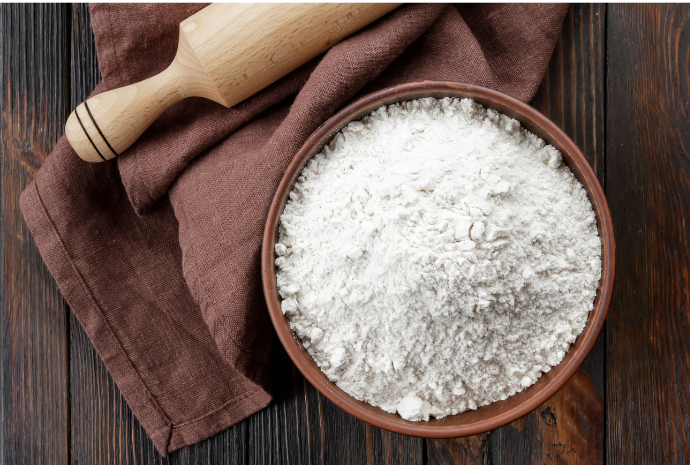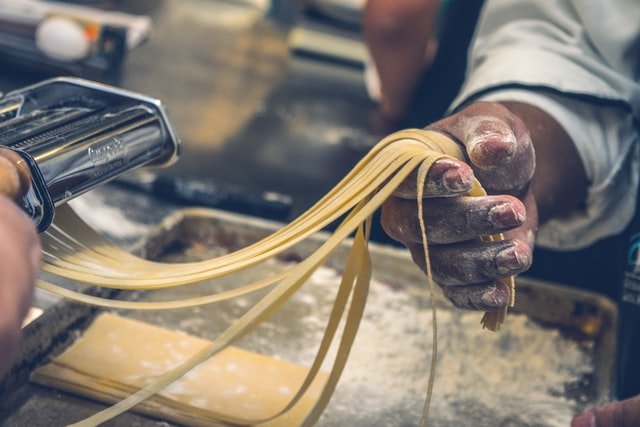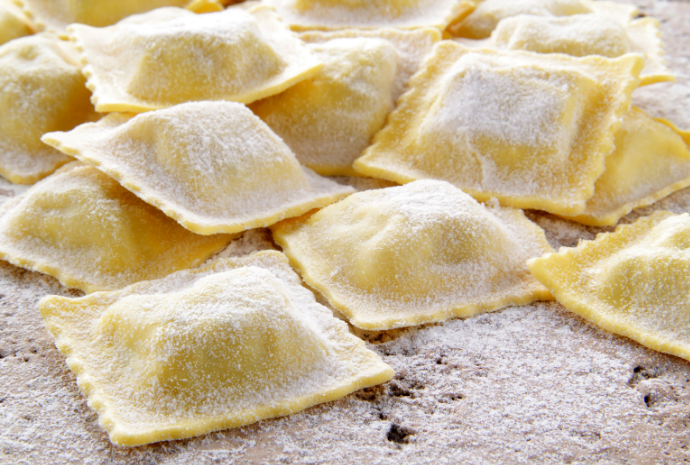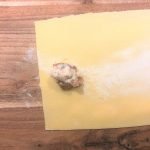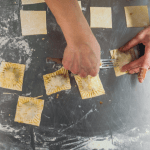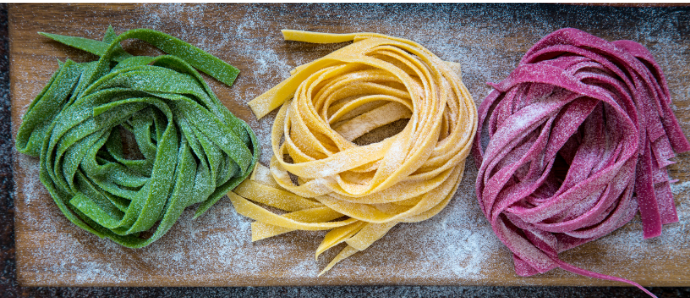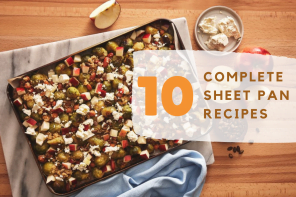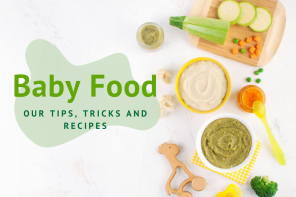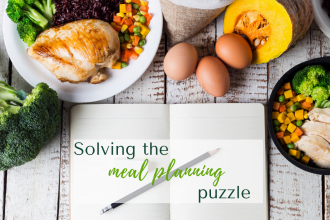Learn everything you need to know about making great homemade pasta.
Whether you’re a kid or a grownup, everybody loves pasta. And although there are many ways to prepare it, the best recipes start with fresh pasta.
We’ve already shown you the different kinds of pasta that exist, as well as delicious recipes that the whole family will love in this article.
So now it’s time to start making your own pasta.
Making fresh pasta? Nope, it’s not as difficult as you think. You might even say it’s easy because it generally takes only 3 ingredients which you most likely have in your pantry.
How to choose your flour?
First, you’ll need flour. The good news is that you can use T55 flour which you probably already have because it’s the so-called all-purpose flour used in all kinds of recipes. It’s slightly less refined than T45 flour – and less expensive, too.
T45 flour, most commonly used in fresh pasta recipes, corresponds to 00, the Italian flour. These numbers tell you the level of flour refinement. The lower the number, the more refined the flour, meaning there won’t be any wheat husk and the flour will, therefore, be less wholegrain.
Now that you understand that, you can start making pasta with classic flour and change it for variety later on.
Basic pasta recipe
Let’s start with the basic pasta recipe. Regardless of which type of pasta you make (spaghetti, ravioli, tagliatelle, etc.), the recipe will always be the same. The difference will be in shape and thickness.
You’ll need:
- 5 eggs
- 2 1/2 c flour
- 2/3 cup semolina flour
NB: If you don’t have semolina flour, you can replace it with all-purpose, but it’ll taste completely different.
You can personalize the dough by adding herbs, spices and even veggies for a little colour. We’ll explain everything a little further down.
Here are the steps for making homemade pasta. You can, of course, skip the food processor and do it all by hand
here are the steps for making your fresh pasta:
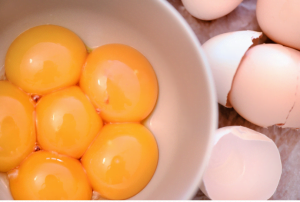
Step 1: Pour the 5 eggs into a food processor bowl.

Step 2: Add the flour.
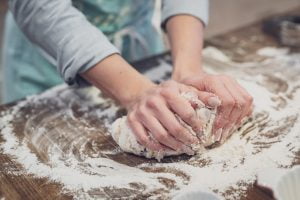
Step 3: Mix everything to form a smooth dough.
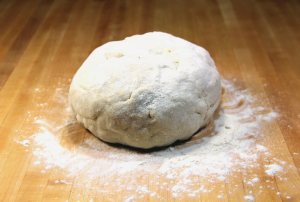
Step 4: Mix for a few minutes to form a smooth ball until the dough is soft and stretchy.
If the dough is too sticky, add a little semolina flour, or all-purpose if you don’t have any semolina.
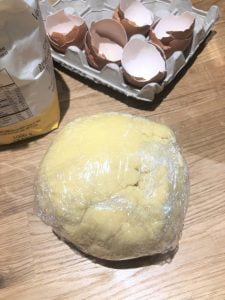
Step 5: Once the ball is formed, wrap it in plastic wrap and let it rest in the fridge for 30 minutes.
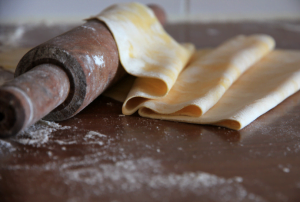
Step 6: Once the dough has rested in a cool place, roll it out with a rolling pin. If you have a pasta machine, choose the desired thickness and follow the machine instructions.
If you don’t have one, don’t panic. We’ll explain how to do it.
How to make pasta without a machine?
I’m sure you’ve seen this gadget before. It’s used to roll out dough and easily obtain the desired thickness for each type of pasta.
Of course, this machine makes life easier for homemade pasta lovers. But no worries. It’s totally doable without one.
Get yourself a rolling pin. Then with just a little effort, it’ll be done. Using the rolling pin, roll out the dough to obtain the desired thickness, then shape your pasta. For example, if you can roll the sheet of pasta, cut it into thin strips, then unroll it.
So ready to take the plunge? We’ll walk you through, step by step.
How to dry pasta?
It’s important to dry fresh pasta. This will prevent it from sticking during cooking and give it a firmer texture because moisture will be removed.
Ideally, dry the pasta about 30 minutes before cooking. The longer the drying time, the longer the cooking time, but the more the pasta will become brittle.
There are several ways to dry pasta. The best way is to hang it. You can use a special drying rack. If you don’t have one,
just use whatever you have at home, like a clothes rack, for example. But you don’t worry. You can also lay it flat on a clean, dry dishtowel.
Cooking time for fresh pasta
Unlike the dry pasta you often get in supermarkets, fresh pasta cooks quickly. It really only takes a few minutes. Cooking time varies with the thickness or type of pasta you make. So it’s important to check the time shown in the recipe before plunging the pasta into boiling water.
Freezing fresh pasta
The good news is that you can make your pasta in advance, so why not make a big batch and freeze it for later?
To preserve its full texture and flavour, we recommend vacuum-sealing fresh uncooked pasta, then freezing it which is be more practical because it’ll take up less space.
If you want to freeze stuffed pasta like ravioli, pre-cook it (about half the recommended cooking time), then let cool before freezing. This step will prevent them from breaking when you thaw them as it makes the dough stretchier.
Don’t forget to eat frozen pasta within 2 or 3 months.
If you intend to enjoy the pasta 3 or 4 days after making it, simply pre-cook it as explained above and keep it in the fridge.
How to make homemade ravioli?
So what’s ravioli? It’s a traditional stuffed pasta: 2 thin layers of dough stuffed with meat or veggies. The advantage of ravioli is that there’s something for everyone.
To start, you’ll need to make a dough by following the steps above.
- Once the dough has rested, divide it into 4.
- Roll each piece until it’s about 3/5″ (1 mm) thick.
- Cut out as many rectangles as possible, about 1″ large and 2″ high.
You can make the ravioli as wide as you like and make circles instead of rectangles.
- Place a rounded teaspoonful of stuffing onto lower half of the rectangle.
- Brush the ravioli edges (around the filling) with water and fold the other half over.
- Press the edges together so that the 2 pieces of pasta stick together. This will prevent the ravioli from opening during cooking and the stuffing from escaping.
You can use the tines of a fork to seal the edges properly.
How many raviolis per person?
It’s a legitimate question, but a complicated one to answer. It depends on the size of the ravioli, what the stuffing is made of, the person enjoying them and their appetite.
In general, 160 to 200 grams per person should be enough. But feel free to make more. You can always keep them in the fridge for a few days or freeze them as explained earlier.
How long should I cook the raviolis for?
Nothing could be simpler than cooking ravioli. The method is the same as for other types of pasta: in a large pot of salted water, boil the ravioli for 5 to 8 minutes.
Drain.
Drizzle with a little olive oil to prevent the pasta from sticking.
Enjoy!
Note: Don’t forget – if you want to freeze your ravioli, cook them only for 2 or 3 minutes. By immersing them in boiling water when defrosting, they’ll finish cooking.
How to color pasta naturally with veggies?
As you can see, making homemade pasta is easy peasy. And to make the recipe even more fun and brighten up your dishes, why not colour your pasta in a completely natural way?
Red, yellow, orange or green – there’s something for everyone!
Here are the ingredients you can use to colour your pasta:
- Fresh green pasta
Try this step-by-step fresh spinach pasta recipe.
- Fresh red or pink pasta
- Beets
- Peppers
- Red kidney beans
- Fresh yellow pasta
- Turmeric (This ingredient isn’t a veggie, so just add a pinch to the flour when you start the recipe)
- Fresh orange pasta
Whichever veggie you choose, you’ll have to puree it until smooth in a blender first. If you’re using fresh veggies, you’ll need to cook them beforehand to get a smooth purée.
Make sure the purée isn’t too watery. To do this, use a sieve to remove any excess liquid.
Add the purée to the dough and knead well.
If the dough is too sticky, add a little flour.
That’s it, your colourful homemade pasta is done. Enjoy!


